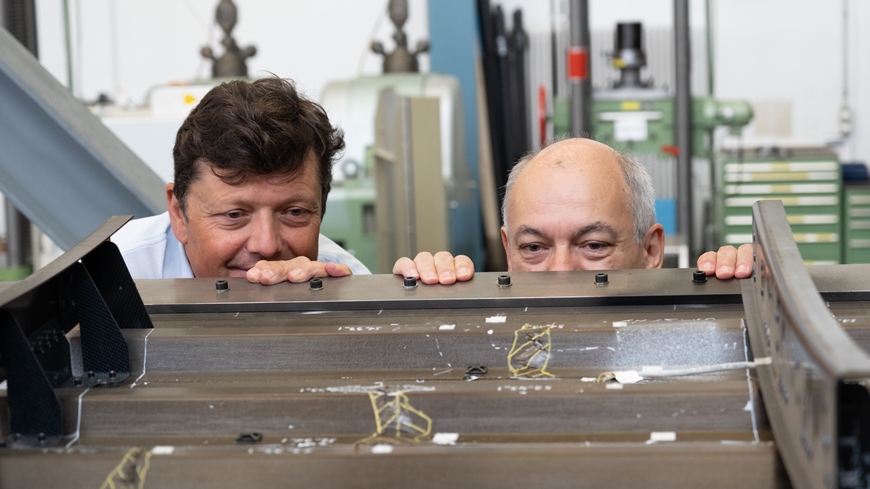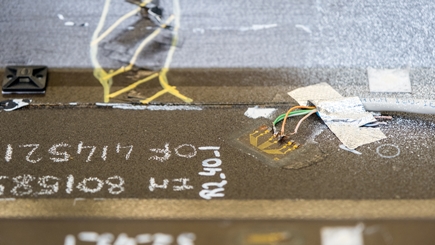Aircraft security
Feel and see emerging microcracks in airplanes
Together with teams from England and Germany, Empa researchers developed a monitoring system for aircraft components. In the future, minor damage could be detected and monitored during flight without the aircraft having to go into the hangar for maintenance. This will reduce operating costs and increase safety at the same time.

The pressurized cabins of commercial aircraft, as well as their wings and tail units, are inspected for cracks and damage at regular intervals. Every six to ten years, each jet has to undergo a D-check in a hangar for one to two months. There, it is largely disassembled, even the paint is removed. Together with the lost operating time, such a D-check can easily cost several million Swiss francs.
Couldn't it be simpler? Couldn't the stressed parts of the aircraft structure also be monitored permanently, i.e. during the flight, and any damage that occurs be specifically monitored? As part of an EU-funded project called DIMES (Development of Integrated Measurement Systems), an international research consortium has been investigating this idea. Besides Empa, the project partners are Airbus, the University of Liverpool, the companies Strain Solutions Ltd. from Great Britain and Dantec Dynamics GmbH from Germany.
Where is it? How bad is it?

"We applied for the project in February 2018, which was launched as part of the EU's Clean Sky 2 program," explains Erwin Hack, the project manager at Empa. The question was an exciting one: Using components that were as robust and inexpensive as possible, the researchers were to monitor the metallic wing of an Airbus A320 and carbon fiber composites in the cabin panel of an Airbus A350. Hack: "The sensors were to answer several questions at the same time: Is there any damage? Where is the damage? What is the nature of the damage? How serious is the damage, and how long will the component last?"
The consortium was awarded the contract, and Empa played no small role: On the one hand, Hack is a specialist in optical monitoring of components, thermal imaging measurements and monitoring using strain gauges and Bragg gratings. All these methods were to be used on the aircraft parts at the same time. And secondly, Empa has the required infrastructure to clamp in the parts and selectively bent them thousands of times in succession. Hack developed his test strategy together with Silvain Michel from Empa's Mechanical Systems Engineering laboratory. Airbus supplied the approximately seven-meter-long wing segment of an Airbus A320-111 from Filton/UK, which had been damaged in a crash in 1988.Four methods at once
In November 2019, the wing section was clamped in place at Empa, and the tests began. Hydraulic presses were used to bend the wing 70,000 times while the researchers collected data and analyzed the results. As expected, the bending tests enlarged the fractures the wing had suffered in the crash and led to new cracks.
The researchers "felt" the overall condition of the wing with strain gauges and fiber-optic Bragg sensors. They observed the immediate vicinity of the damage with cameras and infrared cameras – because the bending tests generate heat in the damaged wing section. Where heat is generated, it's important to look particularly closely.
Pandemic as a challenge
The next step was to adapt the testing methods from metal wings to carbon fiber structures of an aircraft: Airbus in Toulouse provided the cockpit of an Airbus, and Empa received fuselage panels of an Airbus A350 from Hamburg. Both parts are stressed primarily by the cabin pressure, which is built up during each flight and released again during each landing.
But then came Corona. Now the research teams in Chesterfield and Liverpool, in Ulm and Dübendorf, could no longer meet or travel to their test objects, which were in the laboratories in Dübendorf, Toulouse and Filton. The researchers solved the problem by developing a special communication system for mechanics, consisting of a helmet camera, head- and microphone. Thus equipped, a specialist in Toulouse was able to mount the module in the cockpit structure – guided remotely by experts in England, Germany and from Empa. The method worked so well that an aeronautics research laboratory in Ottawa, Canada, eventually joined the project. There, an aircraft wing was fitted with the monitoring module without the need for a single long-distance flight to the research object.
First use in structural tests
The result of the project is a small module made of commercially available, low-cost components that can simultaneously handle four monitoring methods: strain measurements with measuring strips and Bragg sensors, optical monitoring and thermoelastic stress analysis. The data from the sensors is collected in a minicomputer and can be read out remotely.
Initially, the module will not be allowed to fly in aircraft yet, but will prove what it can do during structural tests in Airbus development labs. As the technology matures, it could play a key role in improving aircraft safety while reducing maintenance costs. The next generation of airliners could also be built somewhat lighter and thus more fuel-efficient than today thanks to such structural monitoring.
-
Share






